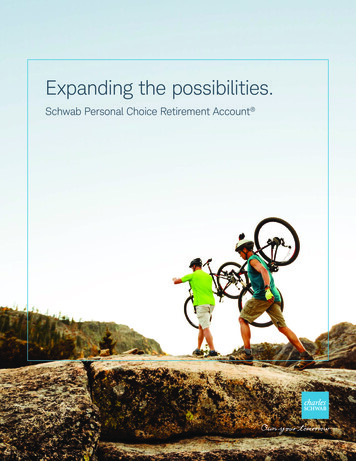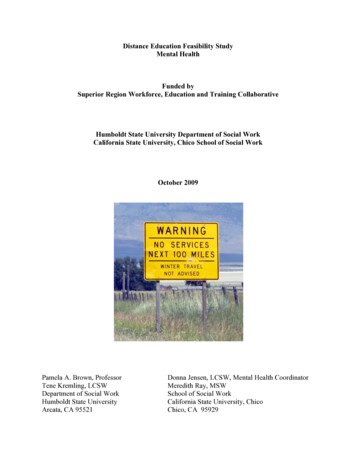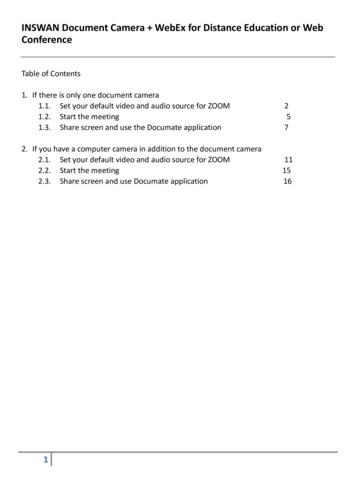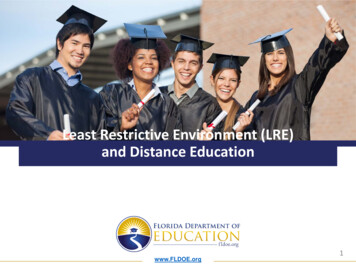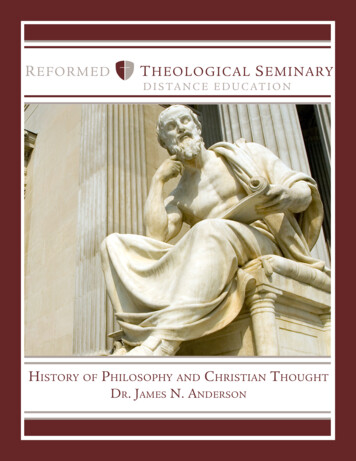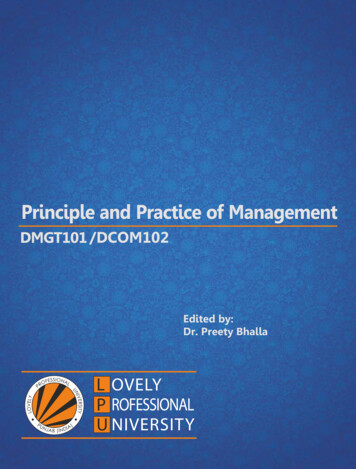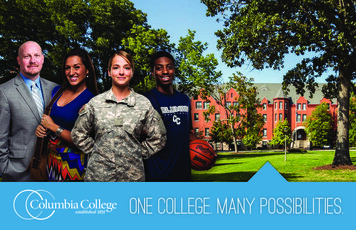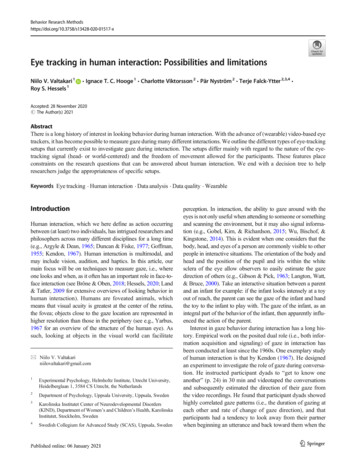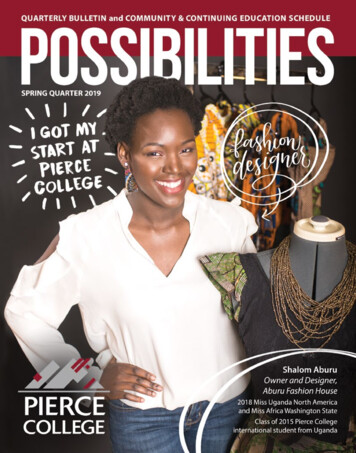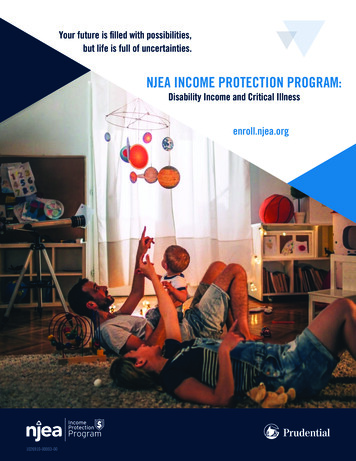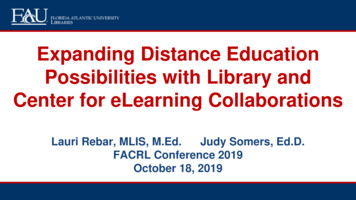
Transcription
Expanding Distance EducationPossibilities with Library andCenter for eLearning CollaborationsLauri Rebar, MLIS, M.Ed.Judy Somers, Ed.D.FACRL Conference 2019October 18, 2019
How did we get started? Training through the eCertification Workshop introducedlibrarians to the pedagogical foundation to distancelearning alongside faculty. Individual discussions led to questions, orientations,presentations, and mutual learning.
Online Facilitator CertificationThe 8 week eCertification workshop isstructured so that the faculty memberis building some components of anonline course (or revising existingones) as they move through thedifferent units. This workshop isfocused on best practices in coursedesign and facilitation.
Progress by Baby Steps Shared committee work andProfessional Developmentpresentations have laid the foundationfor faculty awareness, opencommunication, and joint support offaculty. The association of these two academic units results in bringingnew skills, involvement of faculty, and sharing of effectivepractices, resources, and collective wisdom across ourcommunity of practice.
A more formal structure Evolved to include monthly liverecorded Professional Developmentsessions and interactive staffby librarystaff. trainingWhat doesthis mean? How was it coordinated?Who was involved from both entities?Purpose of the more formal structure?Identify the Components of the collaborative interactions.
Responses to the shared informationeCertification participants were invited to join someprofessional development sessions, have an opportunity to learn more about the library, and itsservices and resources.
eCertification Faculty Responses“Reflection on training:I received my PhD in the Summer of 2017, so I associate thelibrary with my student time at FAU. I have not thought muchabout using library resources in my classes as a guide forstudents whether they are online or F2F. After viewing theprofessional development video, I realize that there is awealth of information on the library website that may beincorporated into my class.”
eCertification Faculty Responses“There are at least two areas that I will include in next semester’s courses: theLibrary DIY guide and APA boot camp. The Library DIY guide will beespecially useful, since it includes easy to navigate common questions.Students prefer a quick source of information, and this will be ideal for them –at their fingertips. The APA boot camp is a great way to introduce the studentto the basics. In the College of Nursing, it is important for the students tounderstand APA format, since we use it for scholarly papers and discussionboards. It can be quite daunting when a student has never had to write thisway. For myself, I will utilize the Faculty guide, which includes informationfrom the Canvas Assignment builder to Software Help & training. This linkwill definitely be one of my favorites.”
Library PD Sessions presented and well received APA Boot CampAssignment BuilderCourse ReservesCredo Information Literacy(now Credo Instruct)DDA eBooksEffective practices foreFacultyFaculty LibGuideExpanding student use ofinformation sources withlibrary assignments
Library PD Sessions presented and well received Digital Government informationresources and maps Introduction to LibGuides Introduction to Library Services Introduction to Library Website Literature Review 101 (how-to) Live guided tour of JaffeCenter for Book Arts facilityand items Quality Matters rubric 4.3(copyright and attribution) Streaming Videos Images (copyright, Creative
Collaborative PD Sessions and Presentations Book reviews, amazingarticles, and websites thatspark Excitement (PD) Collaborations: FAU Librariesand Center for eLearning[Florida Distance LearningAssociation Conference 2019] Concept Mapping and MindMapping (PD)from: Study Habits: How to Mind Map
Collaborative PD Sessions and Presentations Distance LearnerseResources for Faculty (PD)Infographics (PD)Media Literacy (PD)Quality Matters rubric 4.3(Copyright and Attribution)[Florida Distance LearningAssociation Conference 2019,PD Fall 2019)
PD Sessions are Collaborative, andTechnology Driven Introduce Sli.do, Padlet, andother apps for interaction Participation during sessionvia Chat and Microphone Panel Discussions Coffee Chat with Faculty Faculty join sessions via Face to Face alongside the presenters Online through WebEx PowerPoints and links sent to attendees after events Video recorded for editing and later YouTube posting Weekly Sessions
As the library and its resources havebeen further incorporated into theCenter for eLearning, additionalphone calls,drop-ins, andsharingbetween both entities has occurred, totheir mutual benefit, and that of thefaculty they both serve.
Questions from Center for eLearningfor librarians and library staff Citation help (also in Spanish) Copyright questions Course reserves - how to, whatto expect, etc. Locating alternative materials tobe used in Canvas LMS Locating images and their useinformation for inclusion inCanvas LMS reverse image searchingwith TinEye or GoogleImages
Questions from Center for eLearningfor librarians and library staff Locating specific materialsavailable for use: books,journal articles, poems,images, etc.Open EducationalResources Locating articles to use in PD Streaming videos, locatingsome and best practices forshowing videos in onlinecourses Use and attribution of images(copyright, Creative Commons)
Resources shared across the breezewayinclude Articles Conference opportunities eCertification Community ofPractice GIS (Geographic Info Systems) Infographics Instructional Design Open Educational Resources(OER) Pedagogy Presentation opportunities Professional Developmentopportunities and Ideas
Resources shared across the breezewayinclude Rubrics Technology sites Diigo (bookmarking)eLearning by Tracy Parish on ZEEFKathy Schrock’s Guide to EverythingSymbaloo (& our Symbaloo) Templates Webinars Websites Educause Teaching Professor eLearning Coach (Connie Malamed)
Special Projects collaboratively Lauri finished her Instructional Technology Masters degree in May2019, doing her fieldwork class with CeL as a SME (subject matterexpert), co-creating a module on copyright for FAU faculty in CanvasLMS. Our Instruction & Engagement Services Department librarians arecrafting the final content based upon the Blueprint for the module,including assessments, handouts, lessons, and producing videos. Lauri will jointly create the modules in Canvas with the final content. OER: Working one-on-one with faculty and CeL to find OER resourcesfor faculty creating Creative Commons materials.
How can you get involved in your campus? Have a university-wide liaison program (not just toacademic programs) Contact your eLearning resources department oncampus Know what you can and cannot provide to them Copyright, technology, library resources,LibGuides, liaisons Participate in Teaching with Technology or othercampus-wide initiatives to faculty Present on topics: Padlet, Screencast-o-Matic,LibGuides, etc.
How can you get involved in your campus? Attend Professional Development Sessionson campus Work with OER initiatives on campus (if thelibrary is in charge, do extensive outreach,not just to academics) Market library services, facility, andpersonnel constantly Donuts with the Dean, Library Cart aroundcampus and at orientations, follow yourlibrary news and share it with others
Our evaluation of the potential forfuture planning We will incorporate components of the sharedteam efforts as this interactive relationship isdevelopedand strengthened. The connections built in this process provide scaffoldingfor both academic units, including the faculty whoparticipate in the Professional Development sessionsand interact directly with both groups. Looking to the future, there is great potential for our jointcreative support of faculty for continued studentsuccess.
Articles of interestBarrett, L., & Harding, K. (2017). Librarians are in the house! Unconventional strategies for outreachto your campus community. Association of College and Research Libraries ConferenceProceedings 2017, Baltimore, MD. Retrieved riansAreintheHouse.pdfBishop, K. (2018). Don’t wait for them to come to you: Partnering with student support services.In K.Brown, D. Gilchrist, S. Goek, L. J. Hinchliffe, K. J. Malenfant, C. Ollis, and A. Payne (Eds),Shaping the campus conversation on student learning and experience: Activating the results ofassessment in action. Chicago, IL: Association of College and Research Libraries. Retrieved tent.cgi?article 1034&context crisslibfacpubDahl, C. (2007). Library liaison with non-academic units: A new application for a traditional model.Partnership: The Canadian Journal of Library and Information Practice and Research, Serpico, J. M. (2016). Reaching university students via partnerships with non-academic departments.Proceedings of the Conference for Entrepreneurial Librarians, 2, 9-15. Retrieved ad/1457/1081
Have questions?Please ask us.
For more information, please contactLauri Rebar, MLIS, M.Ed.Lrebar@fau.eduJudy Somers, Ed.D.Jsomers@fau.edu
Collaborations: FAU Libraries and Center for eLearning [Florida Distance Learning Association Conference 2019] Concept Mapping and Mind Mapping (PD) from: Study Habits: How to Mind Map. Collaborative PD Sess
